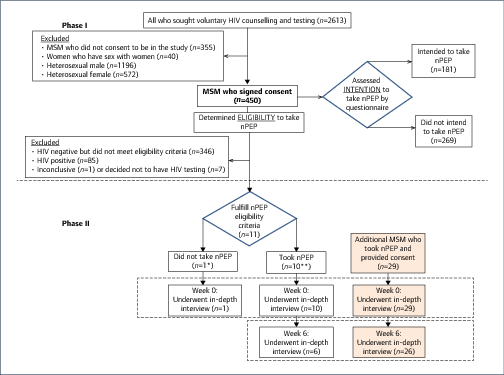
Factors associated with intention to take non-occupational HIV post-exposure prophylaxis among Thai men who have sex with men
| Author List |
|---|
| Nitiya Chomchey |
| Thira Woratanarat |
| Narın Hiransuthikul |
| Somrat Lertmaharit |
| Vitool Lohsoonthorn |
| Nipat Teeratakulpisarn |
| Suteeraporn Pinyakorn |
| James LK Fletcher |
| Duanghathai Suttichom |
| Praphan Phanuphak |
| Jintanat Ananworanich |
| Nittaya Phanuphak |
Abstract
Background: Men who have sex with men (MSM) are disproportionately infected with HIV in Thailand. Factors affecting their intention to take non-occupational HIV post-exposure prophylaxis (nPEP) are not well understood. This study sought to determine factors associated with an intention to take nPEP in this population. Method: This is a two-phase mixed-method study. Phase I was a cross-sectional survey of intention to take nPEP in 450 MSM attending for HIV testing, using a self-administered questionnaire. Phase II was a prospective descriptive study, using an in-depth interview among 40 MSM who had been exposed to HIV in the past 72 hours. Multiple logistic regression was used to evaluate factors relating to the intention to use nPEP. Results: Among 450 MSM seeking HIV testing in Bangkok, 7% had ever taken nPEP. Only 40% expressed an intention to take it to prevent HIV acquisition, despite the fact that they were at high risk as evidenced by an 18.9% prevalence of HIV-positive status. Factors associated with an intention to take nPEP were awareness about nPEP, HIV knowledge, mode of sexual intercourse and circumcision. Among 40 MSM who were eligible for and offered nPEP, 39 agreed to take it, and all but one completed the 4-week course. Condom use increased and all 32 individuals who could be contacted tested HIV negative after nPEP. Conclusion: A high HIV prevalence was found in MSM testing for HIV in this study. However, fewer than half of the participants expressed the intention to take nPEP if they were at risk for HIV infection. Efforts to create nPEP awareness and improve HIV knowledge in MSM are crucial to the successful implementation of nPEP as part of a combination package for HIV prevention in this high-risk population.
Published
Article Category
HIV Treatment
Article Type
Original research
Posted Date
01-07-2017
| File Name |
|---|
| 1498898703jve-3-128.pdf |
 jve-3-128-g001.gif |